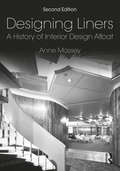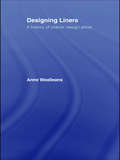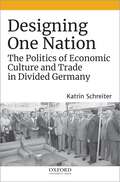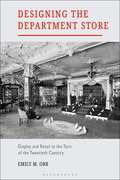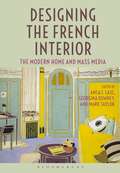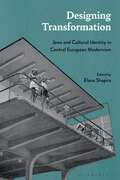- Table View
- List View
Designing Liners: A History of Interior Design Afloat
by Anne MasseyDesigning Liners: A History of Interior Design Afloat covers the interior design of these floating palaces from the mid-nineteenth century to the twenty-first century. In this new edition, the design heritage of the ocean liner is also explored in this age of a growing holiday cruise market. The book offers the first history and analysis of this highly significant aspect of the design of interiors, which mirrors and reinforces cultural assumptions about national identity, gender, class, and ethnicity. The interiors of ocean liners reflect the changing hierarchies of society and shifting patterns of globalization. The trajectory of the professionalization of interior design is the connecting narrative of the book, from the local decorating firm to the internationally renowned architect. It is an important addition to interior design research and takes this transitory building type as its subject. This book provides the first survey of the transient history of interior design in relation to the development of passenger shipping. The history of these great ship interiors is tracked, from their commissioning by the line owners; the materials, methods, and sources for the initial creation; their construction; their use; and their reception. The demise and re-purposing of the interiors is also covered in this new edition, with additional material on the South African Union Castle and P & O Lines. Drawing on a broad range of original research, Anne Massey’s approach combines interior design studies, design history, architectural history, and maritime studies. The new edition has been carefully designed to include black and white and colour illustrations.
Designing Liners: A History of Interior Design Afloat
by Anne MasseyDesigning Liners: A History of Interior Design Afloat covers the interior design of these floating palaces from the mid-nineteenth century to the twenty-first century. In this new edition, the design heritage of the ocean liner is also explored in this age of a growing holiday cruise market. The book offers the first history and analysis of this highly significant aspect of the design of interiors, which mirrors and reinforces cultural assumptions about national identity, gender, class, and ethnicity. The interiors of ocean liners reflect the changing hierarchies of society and shifting patterns of globalization. The trajectory of the professionalization of interior design is the connecting narrative of the book, from the local decorating firm to the internationally renowned architect. It is an important addition to interior design research and takes this transitory building type as its subject. This book provides the first survey of the transient history of interior design in relation to the development of passenger shipping. The history of these great ship interiors is tracked, from their commissioning by the line owners; the materials, methods, and sources for the initial creation; their construction; their use; and their reception. The demise and re-purposing of the interiors is also covered in this new edition, with additional material on the South African Union Castle and P & O Lines. Drawing on a broad range of original research, Anne Massey’s approach combines interior design studies, design history, architectural history, and maritime studies. The new edition has been carefully designed to include black and white and colour illustrations.
Designing Liners: A History of Interior Design Afloat
by Anne WealleansThis in-depth history of the interior design of ocean liners surveys the transient history of interior design in relation to the development of passenger shipping, from commissioning by the line owners, methods and sources for the original creation of designs through to its construction, use and influence. It is a short-lived branch of architecture and design, lasting an average of fifteen years. As the design and taste mirrors and reinforces cultural assumptions about national identity, gender, class and race, not only did the interiors of ocean going liners reflect the changing hierarchies of society and shifting patterns in globalization, but the glamour and styling of the liners were reflected back into the design of interiors on land. Combining design history, architecture history, material and visual cultures, Designing Liners is a richly multidisciplinary work for those studying or researching this application of interior design.
Designing Liners: A History of Interior Design Afloat
by Anne WealleansThis in-depth history of the interior design of ocean liners surveys the transient history of interior design in relation to the development of passenger shipping, from commissioning by the line owners, methods and sources for the original creation of designs through to its construction, use and influence. It is a short-lived branch of architecture and design, lasting an average of fifteen years. As the design and taste mirrors and reinforces cultural assumptions about national identity, gender, class and race, not only did the interiors of ocean going liners reflect the changing hierarchies of society and shifting patterns in globalization, but the glamour and styling of the liners were reflected back into the design of interiors on land. Combining design history, architecture history, material and visual cultures, Designing Liners is a richly multidisciplinary work for those studying or researching this application of interior design.
Designing Modern Norway: A History of Design Discourse
by Kjetil FallanDesigning Modern Norway: A History of Design Discourse is an intellectual history of design and its role in configuring the modern Norwegian nation state. Rather than a conventional national design history survey that focuses on designers and objects, this is an in-depth study of the ideologies, organizations, strategies and politics that combined might be said to have "designed" the modern nation's material and visual culture. The book analyses main tropes and threads in the design discourse generated around key institutions such as museums, organisations and magazines. Beginning with how British and continental design reform ideas were mediated in Norway and merged with a nationalist sentiment in the late nineteenth century, Designing Modern Norway traces the tireless and wide-ranging work undertaken by enthusiastic and highly committed design professionals throughout the twentieth century to simultaneously modernise the nation by design and to nationalise modern design. Bringing the discussion up towards the present, the book concludes with an examination of how Norway's new-found wealth has profoundly changed the production, mediation and consumption of design.
Designing Modern Norway: A History of Design Discourse
by Kjetil FallanDesigning Modern Norway: A History of Design Discourse is an intellectual history of design and its role in configuring the modern Norwegian nation state. Rather than a conventional national design history survey that focuses on designers and objects, this is an in-depth study of the ideologies, organizations, strategies and politics that combined might be said to have "designed" the modern nation's material and visual culture. The book analyses main tropes and threads in the design discourse generated around key institutions such as museums, organisations and magazines. Beginning with how British and continental design reform ideas were mediated in Norway and merged with a nationalist sentiment in the late nineteenth century, Designing Modern Norway traces the tireless and wide-ranging work undertaken by enthusiastic and highly committed design professionals throughout the twentieth century to simultaneously modernise the nation by design and to nationalise modern design. Bringing the discussion up towards the present, the book concludes with an examination of how Norway's new-found wealth has profoundly changed the production, mediation and consumption of design.
Designing One Nation: The Politics of Economic Culture and Trade in Divided Germany
by Katrin SchreiterThis is an open access title available under the terms of a CC BY-NC-ND 4.0 International License. It is free to read at Oxford Scholarship Online and offered as a free PDF download from OUP and selected open access locations, thanks to a generous grant from the Andrew W. Mellon Foundation. The histories of East and West Germany traditionally emphasize the Cold War rivalries between the communist and capitalist nations. Yet, even as the countries diverged in their political directions, they had to create new ways of working together economically. In Designing One Nation, Katrin Schreiter examines the material culture of increasing economic contacts in divided Germany from the 1940s until the 1990s. Trade events, such as fairs and product shows, became one of the few venues for sustained links and knowledge between the two countries after the building of the Berlin Wall. Schreiter uses industrial design, epitomized by the furniture industry, to show how a network of politicians, entrepreneurs, and cultural brokers attempted to nationally re-inscribe their production cultures, define a postwar German identity, and regain economic stability and political influence in postwar Europe. What started as a competition for ideological superiority between East and West Germany quickly turned into a shared, politically legitimizing quest for an untainted post-fascist modernity. This work follows products from the drawing board into the homes of ordinary Germans to offer insights into how converging visions of German industrial modernity created shared expectations about economic progress and living standards. Schreiter reveals how intra-German and European trade policies drove the creation of products and generated a certain convergence of East and West German taste by the 1980s. Drawing on a wide range of sources from governments, furniture firms, industrial design councils, home lifestyle magazines, and design exhibitions, Designing One Nation argues that an economic culture linked the two Germanies even before reunification in 1990.
Designing One Nation: The Politics of Economic Culture and Trade in Divided Germany
by Katrin SchreiterThis is an open access title available under the terms of a CC BY-NC-ND 4.0 International License. It is free to read at Oxford Scholarship Online and offered as a free PDF download from OUP and selected open access locations, thanks to a generous grant from the Andrew W. Mellon Foundation. The histories of East and West Germany traditionally emphasize the Cold War rivalries between the communist and capitalist nations. Yet, even as the countries diverged in their political directions, they had to create new ways of working together economically. In Designing One Nation, Katrin Schreiter examines the material culture of increasing economic contacts in divided Germany from the 1940s until the 1990s. Trade events, such as fairs and product shows, became one of the few venues for sustained links and knowledge between the two countries after the building of the Berlin Wall. Schreiter uses industrial design, epitomized by the furniture industry, to show how a network of politicians, entrepreneurs, and cultural brokers attempted to nationally re-inscribe their production cultures, define a postwar German identity, and regain economic stability and political influence in postwar Europe. What started as a competition for ideological superiority between East and West Germany quickly turned into a shared, politically legitimizing quest for an untainted post-fascist modernity. This work follows products from the drawing board into the homes of ordinary Germans to offer insights into how converging visions of German industrial modernity created shared expectations about economic progress and living standards. Schreiter reveals how intra-German and European trade policies drove the creation of products and generated a certain convergence of East and West German taste by the 1980s. Drawing on a wide range of sources from governments, furniture firms, industrial design councils, home lifestyle magazines, and design exhibitions, Designing One Nation argues that an economic culture linked the two Germanies even before reunification in 1990.
Designing Russian Cinema: The Production Artist and the Material Environment in Silent Era Film (KINO - The Russian and Soviet Cinema)
by Eleanor ReesThis book highlights the significant role that production artists played when Russian cinema was still in its infancy. It uncovers Russian cinema's connections with other art forms, examining how production artists drew on both aesthetic traditions and modernist experiments in architecture, painting and theatre as they explored the new medium of cinema and its potential to engender new models of perception and forms of audience engagement.Drawing on set design sketches, archival documents and film-makers' memoirs, Eleanor Rees reveals how less-canonical films such as Behind the Screen (Kulisy ekrana, 1919) and Palace and Fortress (Dvorets i krepost´, 1923), were remarkable from a design perspective, and also provides new readings of well-known films, such as Children of the Age (Deti veka, 1915) and Strike (Stachka, 1925). Rees brings to light information on significant but understudied figures such as Vladimir Egorov and Sergei Kozlovskii, and highlights the involvement of well-known figures such as Lev Kuleshov and Aleksandr Rodchenko. Unlike the majority of late Imperial directors and camera operators, many early-Russian production artists continued to work in cinema in the Soviet era and to draw on practices forged before the 1917 Revolution. In spanning the entire silent era, this book highlights the often overlooked continuities between the late-Imperial and early-Soviet periods of cinema, thus questioning traditional historical periodisations.
Designing Russian Cinema: The Production Artist and the Material Environment in Silent Era Film (KINO - The Russian and Soviet Cinema)
by Eleanor ReesThis book highlights the significant role that production artists played when Russian cinema was still in its infancy. It uncovers Russian cinema's connections with other art forms, examining how production artists drew on both aesthetic traditions and modernist experiments in architecture, painting and theatre as they explored the new medium of cinema and its potential to engender new models of perception and forms of audience engagement.Drawing on set design sketches, archival documents and film-makers' memoirs, Eleanor Rees reveals how less-canonical films such as Behind the Screen (Kulisy ekrana, 1919) and Palace and Fortress (Dvorets i krepost´, 1923), were remarkable from a design perspective, and also provides new readings of well-known films, such as Children of the Age (Deti veka, 1915) and Strike (Stachka, 1925). Rees brings to light information on significant but understudied figures such as Vladimir Egorov and Sergei Kozlovskii, and highlights the involvement of well-known figures such as Lev Kuleshov and Aleksandr Rodchenko. Unlike the majority of late Imperial directors and camera operators, many early-Russian production artists continued to work in cinema in the Soviet era and to draw on practices forged before the 1917 Revolution. In spanning the entire silent era, this book highlights the often overlooked continuities between the late-Imperial and early-Soviet periods of cinema, thus questioning traditional historical periodisations.
Designing San Francisco: Art, Land, and Urban Renewal in the City by the Bay
by Alison IsenbergA major new urban history of the design and development of postwar San FranciscoDesigning San Francisco is the untold story of the formative postwar decades when U.S. cities took their modern shape amid clashing visions of the future. In this pathbreaking and richly illustrated book, Alison Isenberg shifts the focus from architects and city planners—those most often hailed in histories of urban development and design—to the unsung artists, activists, and others who played pivotal roles in rebuilding San Francisco between the 1940s and the 1970s.Previous accounts of midcentury urban renewal have focused on the opposing terms set down by Robert Moses and Jane Jacobs—put simply, development versus preservation—and have followed New York City models. Now Isenberg turns our attention west to colorful, pioneering, and contentious San Francisco, where unexpectedly fierce battles were waged over iconic private and public projects like Ghirardelli Square, Golden Gateway, and the Transamerica Pyramid.When large-scale redevelopment came to low-rise San Francisco in the 1950s, the resulting rivalries and conflicts sparked the proliferation of numerous allied arts fields and their professionals, including architectural model makers, real estate publicists, graphic designers, photographers, property managers, builders, sculptors, public-interest lawyers, alternative press writers, and preservationists. Isenberg explores how these centrally engaged arts professionals brought new ideas to city, regional, and national planning and shaped novel projects across urban, suburban, and rural borders. San Francisco’s rebuilding galvanized far-reaching critiques of the inequitable competition for scarce urban land, and propelled debates over responsible public land stewardship. Isenberg challenges many truisms of this renewal era—especially the presumed male domination of postwar urban design, showing how women collaborated in city building long before feminism’s impact in the 1970s.An evocative portrait of one of the world’s great cities, Designing San Francisco provides a new paradigm for understanding past and present struggles to define the urban future.
Designing San Francisco: Art, Land, and Urban Renewal in the City by the Bay (PDF)
by Alison IsenbergA major new urban history of the design and development of postwar San FranciscoDesigning San Francisco is the untold story of the formative postwar decades when U.S. cities took their modern shape amid clashing visions of the future. In this pathbreaking and richly illustrated book, Alison Isenberg shifts the focus from architects and city planners—those most often hailed in histories of urban development and design—to the unsung artists, activists, and others who played pivotal roles in rebuilding San Francisco between the 1940s and the 1970s.Previous accounts of midcentury urban renewal have focused on the opposing terms set down by Robert Moses and Jane Jacobs—put simply, development versus preservation—and have followed New York City models. Now Isenberg turns our attention west to colorful, pioneering, and contentious San Francisco, where unexpectedly fierce battles were waged over iconic private and public projects like Ghirardelli Square, Golden Gateway, and the Transamerica Pyramid.When large-scale redevelopment came to low-rise San Francisco in the 1950s, the resulting rivalries and conflicts sparked the proliferation of numerous allied arts fields and their professionals, including architectural model makers, real estate publicists, graphic designers, photographers, property managers, builders, sculptors, public-interest lawyers, alternative press writers, and preservationists. Isenberg explores how these centrally engaged arts professionals brought new ideas to city, regional, and national planning and shaped novel projects across urban, suburban, and rural borders. San Francisco’s rebuilding galvanized far-reaching critiques of the inequitable competition for scarce urban land, and propelled debates over responsible public land stewardship. Isenberg challenges many truisms of this renewal era—especially the presumed male domination of postwar urban design, showing how women collaborated in city building long before feminism’s impact in the 1970s.An evocative portrait of one of the world’s great cities, Designing San Francisco provides a new paradigm for understanding past and present struggles to define the urban future.
Designing San Francisco: Art, Land, and Urban Renewal in the City by the Bay
by Alison IsenbergA major new urban history of the design and development of postwar San FranciscoDesigning San Francisco is the untold story of the formative postwar decades when U.S. cities took their modern shape amid clashing visions of the future. In this pathbreaking and richly illustrated book, Alison Isenberg shifts the focus from architects and city planners—those most often hailed in histories of urban development and design—to the unsung artists, activists, and others who played pivotal roles in rebuilding San Francisco between the 1940s and the 1970s.Previous accounts of midcentury urban renewal have focused on the opposing terms set down by Robert Moses and Jane Jacobs—put simply, development versus preservation—and have followed New York City models. Now Isenberg turns our attention west to colorful, pioneering, and contentious San Francisco, where unexpectedly fierce battles were waged over iconic private and public projects like Ghirardelli Square, Golden Gateway, and the Transamerica Pyramid.When large-scale redevelopment came to low-rise San Francisco in the 1950s, the resulting rivalries and conflicts sparked the proliferation of numerous allied arts fields and their professionals, including architectural model makers, real estate publicists, graphic designers, photographers, property managers, builders, sculptors, public-interest lawyers, alternative press writers, and preservationists. Isenberg explores how these centrally engaged arts professionals brought new ideas to city, regional, and national planning and shaped novel projects across urban, suburban, and rural borders. San Francisco’s rebuilding galvanized far-reaching critiques of the inequitable competition for scarce urban land, and propelled debates over responsible public land stewardship. Isenberg challenges many truisms of this renewal era—especially the presumed male domination of postwar urban design, showing how women collaborated in city building long before feminism’s impact in the 1970s.An evocative portrait of one of the world’s great cities, Designing San Francisco provides a new paradigm for understanding past and present struggles to define the urban future.
Designing Social Science Research
by Oddbjørn BukveThis book presents different research designs, their respective purposes and merits as well as their underlying assumptions. Research designs are characterised by a certain combination of knowledge aims and strategies for data production. An adequate design is the key to carrying out a successful research project. Nevertheless, the literature on design is scarce, compared to the literature on methods. This book clarifies the basic distinction between variable-oriented designs and case designs, and proceeds to integrated, comparative and intervention-oriented designs. A step-by-step guide to the design process and the choices to make is also included. The book's clear style makes it an excellent guide for master students and PhD students doing their first research exercises, while it is also useful for more experienced researchers who want to broaden their design repertoire and keep up to recent innovations in the field of research design.
Designing the British Post-War Home: Kenneth Wood, 1948-1968 (Routledge Research in Architecture)
by Fiona FisherIn Designing the British Post-War Home Fiona Fisher explores the development of modern domestic architecture in Britain through a detailed study of the work of the successful Surrey-based architectural practice of Kenneth Wood. Wood’s firm is representative of a geographically distinct category of post-war architectural and design practice - that of the small private practice that flourished in Britain’s expanding suburbs after the removal of wartime building restrictions. Such firms, which played an important role in the development of British domestic design, are currently under-represented within architectural histories of the period. The private house represents an important site in which new spatial, material and aesthetic parameters for modern living were defined after the Second World War. Within a British context, the architect-designed private house remained an important ‘vehicle for the investigation of architectural ideas’ by second generation modernist architects and designers. Through a series of case study houses, designed by Wood’s firm, the book reconsiders the progress of modern domestic architecture in Britain and demonstrates the ways in which architectural discourse and practice intersected with the experience, performance and representation of domestic modernity in post-war Britain.
Designing the British Post-War Home: Kenneth Wood, 1948-1968 (Routledge Research in Architecture)
by Fiona FisherIn Designing the British Post-War Home Fiona Fisher explores the development of modern domestic architecture in Britain through a detailed study of the work of the successful Surrey-based architectural practice of Kenneth Wood. Wood’s firm is representative of a geographically distinct category of post-war architectural and design practice - that of the small private practice that flourished in Britain’s expanding suburbs after the removal of wartime building restrictions. Such firms, which played an important role in the development of British domestic design, are currently under-represented within architectural histories of the period. The private house represents an important site in which new spatial, material and aesthetic parameters for modern living were defined after the Second World War. Within a British context, the architect-designed private house remained an important ‘vehicle for the investigation of architectural ideas’ by second generation modernist architects and designers. Through a series of case study houses, designed by Wood’s firm, the book reconsiders the progress of modern domestic architecture in Britain and demonstrates the ways in which architectural discourse and practice intersected with the experience, performance and representation of domestic modernity in post-war Britain.
Designing the Department Store: Display and Retail at the Turn of the Twentieth Century
by Emily M. OrrThe book builds an original argument for the department store as a significant site of design production, and therefore offers an alternative interpretation to the mainstream focus on consumption within retail history. Emily M. Orr presents a fresh perspective on the rise of modern urban consumer culture, of which the department store was a key feature. By investigating the production processes of display as well as fascinating information about display-making's tools and technologies, the skills of the displayman and the meaning and context of design decisions which shaped the final visual effect are revealed. In addition, the book identifies and isolates 'display' as a distinct moment in the life of the commodity, and understands it as an influential channel of mediation in the shopping experience. The assembly and interpretation of a diverse range of previously unexplored primary resources and archives yields fascinating new evidence, showing how display achieved an agency which transformed everyday objects into commodities and made consumers out of passersby.
Designing the Department Store: Display and Retail at the Turn of the Twentieth Century
by Emily M. OrrThe book builds an original argument for the department store as a significant site of design production, and therefore offers an alternative interpretation to the mainstream focus on consumption within retail history. Emily M. Orr presents a fresh perspective on the rise of modern urban consumer culture, of which the department store was a key feature. By investigating the production processes of display as well as fascinating information about display-making's tools and technologies, the skills of the displayman and the meaning and context of design decisions which shaped the final visual effect are revealed. In addition, the book identifies and isolates 'display' as a distinct moment in the life of the commodity, and understands it as an influential channel of mediation in the shopping experience. The assembly and interpretation of a diverse range of previously unexplored primary resources and archives yields fascinating new evidence, showing how display achieved an agency which transformed everyday objects into commodities and made consumers out of passersby.
Designing the European Union: From Paris to Lisbon (Palgrave Studies in European Union Politics)
by Finn LaursenThis book outlines the content of the main treaties that form the 'constitutional' basis of the European Union and analyses changes in these over time. The EU has expanded its policy scope and taken in many more members transferring powers to common supranational institutions in a way seen nowhere else in the world.
Designing the French Interior: The Modern Home and Mass Media
by Anca I. Lasc Georgina Downey Mark TaylorDesigning the French Interior traces France's central role in the development of the modern domestic interior, from the pre-revolutionary period to the 1970s, and addresses the importance of various media, including drawings, prints, pattern books, illustrated magazines, department store catalogs, photographs, guidebooks, and films, in representing and promoting French interior design to a wider audience. Contributors to this original volume identify and historicize the singularity of the modern French domestic interior as a generator of reproducible images, a site for display of both highly crafted and mass-produced objects, and the direct result of widely-circulated imagery in its own right. This important volume enables an invaluable new understanding of the relationship between architecture, interior spaces, material cultures, mass media and modernity.
Designing the French Interior: The Modern Home and Mass Media
by Anca I. Lasc Georgina Downey Mark TaylorDesigning the French Interior traces France's central role in the development of the modern domestic interior, from the pre-revolutionary period to the 1970s, and addresses the importance of various media, including drawings, prints, pattern books, illustrated magazines, department store catalogs, photographs, guidebooks, and films, in representing and promoting French interior design to a wider audience. Contributors to this original volume identify and historicize the singularity of the modern French domestic interior as a generator of reproducible images, a site for display of both highly crafted and mass-produced objects, and the direct result of widely-circulated imagery in its own right. This important volume enables an invaluable new understanding of the relationship between architecture, interior spaces, material cultures, mass media and modernity.
Designing the Urban Renaissance: Sustainable and competitive place making in England
by Francesco VescoviThis book is an academic essay about the urban regeneration policies which have been changing the physical - and partly social - outlook of many English cities during the last 10-15 years, eventually giving birth to a process which is also known as ‘Urban Renaissance’. The main focus is on urban design: the way it has been promoted by the government as an important means for delivering attractive places in more sustainable and competitive cities. The research describes the support given to local authorities for this purpose through new laws and powers, the publishing of planning and design manuals and the delivery of especially dedicated funds, bodies and programmes. It also explores the character and purpose of new developments such as scientific parks, creative/cultural quarters, retail and commercial dis-tricts, public realm works, describing recurring design rules and features. Readers interested in urban policies, architecture and the built environment will find a concise yet comprehensive explanation, enriched by more than a hundred pictures, on why and how many towns and cities like Birmingham, Nottingham, Leicester or Sheffield have been changing during the last decade.
Designing Transformation: Jews and Cultural Identity in Central European Modernism
by Elana ShapiraJewish designers and architects played a key role in shaping the interwar architecture of Central Europe, and in the respective countries where they settled following the Nazi's rise to power. This book explores how Jewish architects and patrons influenced and reformed the design of towns and cities through commercial buildings, urban landscaping and other material culture. It also examines how modern identities evolved in the context of migration, commercial and professional networks, and in relation to the conflict between nationalist ideologies and international aspirations in Central Europe and beyond. Pointing to the production within cultural platforms shared by Jews and Christians, the book's research sheds new light on the importance of integrating Jews into Central European design and aesthetic history. Leading historians, curators, archivists and architects present their critical analyses further to 'design' the past and push forward a transformation in the historical consciousness of Central Europe. By reconsidering the seminal role of Central European émigré and exiled architects and designers in shaping today's global design cultures, this book further strengthens humanistic, progressive and pluralistic cultural trends in Europe today.
Designing Transformation: Jews and Cultural Identity in Central European Modernism
Jewish designers and architects played a key role in shaping the interwar architecture of Central Europe, and in the respective countries where they settled following the Nazi's rise to power. This book explores how Jewish architects and patrons influenced and reformed the design of towns and cities through commercial buildings, urban landscaping and other material culture. It also examines how modern identities evolved in the context of migration, commercial and professional networks, and in relation to the conflict between nationalist ideologies and international aspirations in Central Europe and beyond. Pointing to the production within cultural platforms shared by Jews and Christians, the book's research sheds new light on the importance of integrating Jews into Central European design and aesthetic history. Leading historians, curators, archivists and architects present their critical analyses further to 'design' the past and push forward a transformation in the historical consciousness of Central Europe. By reconsidering the seminal role of Central European émigré and exiled architects and designers in shaping today's global design cultures, this book further strengthens humanistic, progressive and pluralistic cultural trends in Europe today.
Designing US Economic Policy: An Analytical Biography of Leon H. Keyserling
by W. BrazeltonIn Designing US Economic Policy , W. Robert Brazelton analyzes the development of US economic policy in the aftermath of the Second World War. As the world struggled to recover from the massive wartime expenditure, it was essential that economic policy not repeat the mistakes of the prewar era which sparked the 1930s Depression. These policies included Truman's New Deal, which helped shape both the economic and social climate of the USA today.
